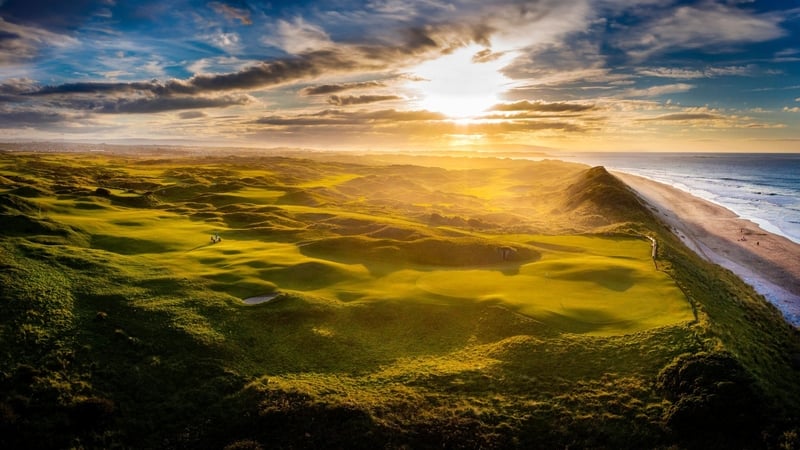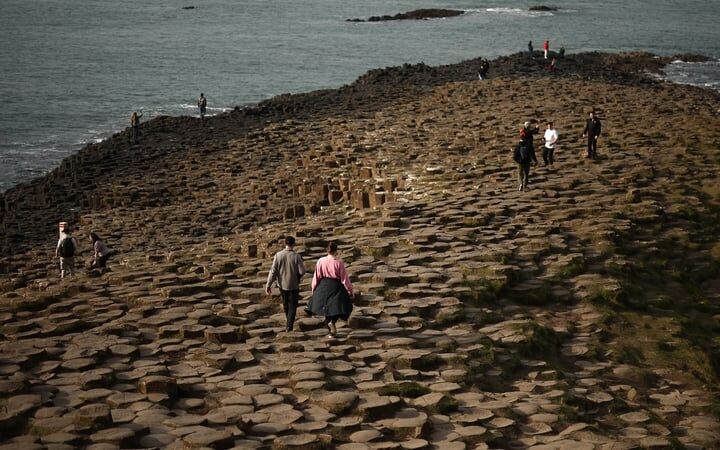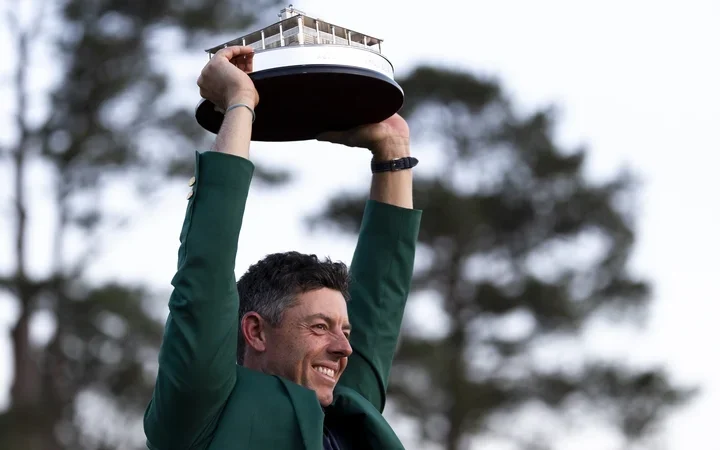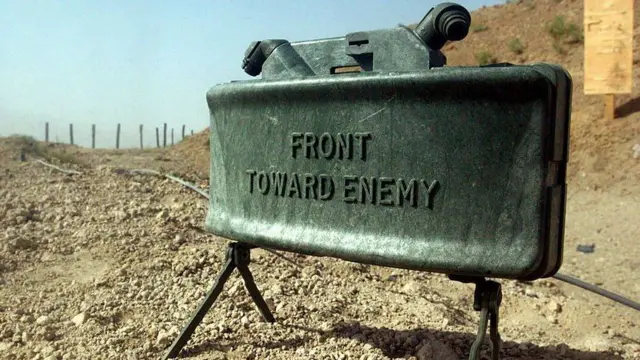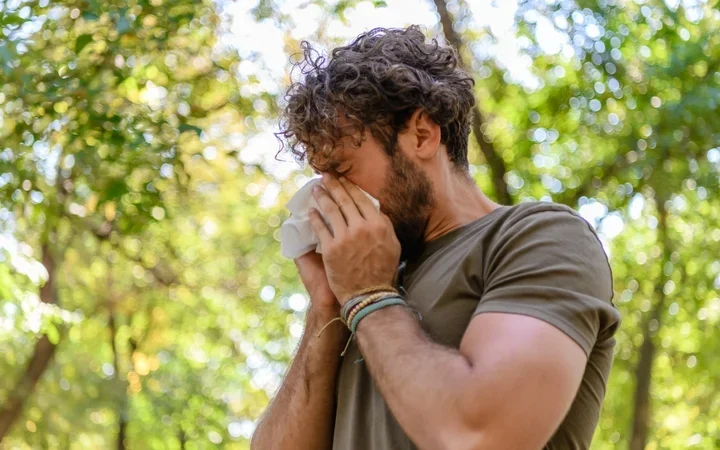I’m standing on a manicured lawn, legs hip-width apart as I shimmy my weight forward. I move the putter back a tiny amount and hit a golf ball wonkily towards the hole.
“It’s a good putt,” PGA pro Charlotte Reid tells me. “You just need to hit it like a pendulum.”
Charlotte is frequently dishing out advice here at Royal Portrush Golf Club – home to The Open for the third time this summer. Around 278,000 people will be heading to Northern Ireland’s prestigious location for the 153rd championship. It’s one of the most sought-after golf courses in the world, and costs visitors like me £385 (roughly €460) to play a round.
It’s one of the reasons some seriously fancy hotels are opening up in and around Portrush – a Northern Irish seaside town full of heart.

On the fourth fairway, the region’s only five-star resort opened in March. Dunluce Lodge’s 35 suites are decked out in earthy shades, creating a calming yet traditional space. Little details – like locally-sourcing everything, free beer* and snacks in the rooms, and chocolate and a bedtime story – give the hotel a homely feel. And the never-ending sunsets can be soaked up from the terrace, open year-round with an outdoor BBQ and firepit.
In land, the Portrush Adelphi has been bought and renovated by Marine & Lawn – their first hotel which isn’t directly on the coast or golf course.
It’s a small, boutique affair with 34 rooms, but it’s the downstairs decor that really stands out. Grand but cool, shiny green tiles frame the bar lined with six plump leather stools. At the bay window, cloaked in long flowing curtains with miniature gold tassels, four revolving Chesterfield tub chairs are upholstered in plush green velvet, and the walls and ceiling are adorned in green corduroy.
Up the road, Hilton’s £11 million (roughly €13 million) hotel The Marcus Portrush is currently being refurbished, set to open on July 1, and a big spa hotel has also got the go ahead to open in nearby Portstewart.

Aside from the golf, there is plenty to do in this part of Northern Ireland.
The untamed coast is home to UNESCO World Heritage Site Giant’s Causeway. The jaw-dropping geological wonder formed almost 60 million years ago from volcanic eruption and slowly-cooling lava. It’s a basalt plateau that has to be seen to be believed, the honeycomb-shaped columns jutting upwards in all shapes and sizes.
I wobble my way up the smooth hexagonal hill, tip-toeing over the Wishing Chair and up to the top for the photograph everyone is here for. Going earlier in the day definitely helps avoid crowds – just watch out for jelly legs on the way down.
As I snap unreal photos from Magheracross viewpoint, looking out over Whiterocks Beach with the rocky Skerries in the distance, crashing surf swooshes and swirls like a belligerent shiver of shark fins, green moss dusting their tips. The sea is as blue as the sky and there’s barely a soul in sight.

Two minutes away, the ruins of Dunluce Castle – built on sheer headland with Causeway stones between the 15th and 17th century – hides rocks, reefs and sea caves. I stumble over the cobbles, admiring the fat, sturdy walls. It’s sprawling and beautiful, much like the coast it overlooks.
Anyone looking to fill up their days with more than just sightseeing can head out on the Causeway Craft Trail – visiting local artisans inspired by their gorgeous surroundings.
The Boat House gallery – complete with a rowing boat strung up to the ceiling and lit with fairy lights – hosts a local craft collective. There’s always an artist here and an array of affordable items to buy. Emer Dixon, who specialises in Irish heritage silver jewellery, plucks a box from her glass storage cabinet – it’s a necklace she’s just finished called Messy Heart, “because everyone’s heart is a wee bit messy”, she says.
At Atlantic Craft, I meet Louise McLean, who teaches us how to weave willow and somehow, magically create decorative swallows.

Louise has been basket weaving for 25 years, has met King Charles III, had pieces bought by celebrities and makes props for big-budget film and TV shows.
“It’s the oldest crafting skill in the world,” she says. “You have to weave using both hands and, because it uses both sides of the brain, it’s really therapeutic.”
My favourite thing to do in Portrush, however, is the Spirit of the Bann foodie tour.
We meet by LIR – undoubtedly the best restaurant in the area – ran by Stevie McCarry (who made the Great British Menu final this year) and his wife Rebekah, who’s responsible for the epic pink walls, glitterballs, Tiffany lampshades and David Shrigley artwork. The whole space looks out onto the riverbank.

I grab our skipper Ian McKnight’s hand and haul myself onto the shiny burgundy M.V. Kingfisher. “It’s the love of my life,” Ian says of his lockdown project.
We take our seats beneath the colourful bunting and miniature festoon lights as Simon Hogg from Dunluce Distillery pours us a large shot of La Riva Nata. His Great Taste award-winner is made with the peel of Sorrento lemons and is the first limoncello born in Ireland.
It’s 11.30am and Ian merrily toots his horn at other boat owners. Tall reeds line the riverbank, spines perfectly upright soaking up the rare sunshine on Northern Ireland’s longest river. We learn all about the area of outstanding natural beauty, the salt marsh and reef beds providing a home to dragonflies, native bluebells and rare orchids.
Simon serves up a Shore Born gin, made with juniper, lavender and cardamom, as the estuary starts to open out.

Native cormorants sit on the jetty, wings outstretched, drying off in the sunshine, while others flap close to the sea, seeking out supper. A family of three stand on a stretch of beach they have all to themselves, as we look out to Mussenden Temple – one of the most photographed places in Ireland – and the hills of county Donegal.
The river becomes a little more undulating, the sun dancing on the ripples, twinkling like diamonds, as we chug our way into the Atlantic.
We stop for lunch and a cheeky cocktail, all served on locally-made slate and wooden platters. Simon shakes up a round of Twilight Shores – gin, blueberry purée, lavender syrup, and mint from his garden – which pairs perfectly with the cheese and charcuterie.
The condiments are phenomenal: Distillers Pickle Sauce – a concoction perfected during lockdown by chef Gary Stewart; a rhubarb chutney made by Amanda Hanna – a farmer’s wife whose farmshop business Jam At The Doorstep has exploded; Irish Black Butter, which is not actually butter, but a delicious sauce made with Armagh Bramley apples; and Dart Mountain Craft Drizzle made with Armagh dry cider, which I pour over an oat biscuit topped with a hunk of cheese and walnuts.
Simon chats about his creations modestly, a squashed cap wonkily placed his head, and we finish the trip with an Irish coffee made with his coffee liqueur.

I may be full of gin and cheese, but romantic plans of upping sticks and moving to Portrush feel like a genuine possibility. The people are friendly, the food and drink is delicious, and the surroundings are utterly beautiful.
I’m not the greatest golfer, but this part of Northern Ireland has much more to offer than those 18 holes, no matter how fancy they are.
